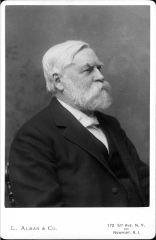


mained an effective bar to Foundation approval. Dr. William M. Lawrence resigned as President of the Board in 1912 to accept the Lectureship in Christian Ethics in the Seminary. Sidney M. Colgate, one of the sons of the late Samuel Colgate and a member of the family soap company, succeeded him. Following Mr. Colgate’s resignation in 1921, his cousin James C. Colgate, became President and was to remain active in that position until 1935.
University finances do not seem to have given President Bryan much worry since he regarded this area of operations as Trustees’ domain. Income during his term increased from $76,000 at the beginning to $231,000 at its conclusion, while expenditures rose from $97,000 to $266,000. A growing enrollment meant additional tuition income but at the same time raised the operating costs. This situation, in part, explains the regular deficits which ranged from a low of $38,000 in 1911 to a high of $66,000 in 1918. All of them James C. Colgate made up with assistance from his mother and sister but, tiring of this practice, he had a budget system instituted in 1921 to provide greater control of expenses. This innovation must have contributed to the reduction of the deficit from $58,000 in 1920 to $26,000 in 1922. The





